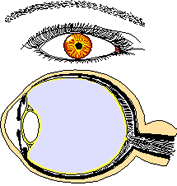 Losing vision is one of the most feared complications of diabetes. And it’s no surprise—our eyes allow us to experience the world, read, drive, recognize faces, and enjoy everyday life.
Losing vision is one of the most feared complications of diabetes. And it’s no surprise—our eyes allow us to experience the world, read, drive, recognize faces, and enjoy everyday life.
Diabetes can damage the eye in different ways, sometimes without any warning signs. Light enters the eye, passing through the cornea and lens to focus, then travels through the clear gel inside the eye to reach the retina. The retina, a thin layer of nerve cells and blood vessels at the back of the eye, converts light into signals that the brain turns into images. When diabetes affects the small blood vessels in the retina, it can lead to vision problems and, in some cases, blindness.
Why Eye Complications Happen
Diabetes damages the tiny blood vessels in the retina over time, a condition known as diabetic retinopathy. Other eye problems, such as macular edema, cataracts, and glaucoma, are also more common in people with diabetes. The good news is that most diabetes-related vision loss can be prevented with early detection and reasonable blood sugar control.
A large study in Wisconsin found that 23% of people with type 1 diabetes (IDDM) and 10% of those with type 2 diabetes (NIDDM) using insulin already had advanced retinopathy—yet many didn’t even know they had it. Because eye damage often has no symptoms in the early stages, regular eye exams are the only way to catch problems before they become serious.
Preventing Vision Loss
The Diabetes Control and Complications Trial (DCCT) showed that keeping blood sugar levels in a healthy range reduces the risk of retinopathy by up to 76%. While reversing eye damage isn’t yet proven, research suggests that better glucose control may help slow or stop the progression of existing problems.
Everyone with type 1 diabetes for five years or more and all people with type 2 diabetes should have a detailed eye exam at least once a year, or as recommended by a doctor.
Explore More on Eye Complications
This article is part of a series covering different eye complications, their development, and what can be done to prevent or treat them. Click the links below to learn more:
- Protecting Your Vision: Understanding Diabetes and Eye Complications
- How Diabetes Affects Your Vision: Early Changes and What to Expect
- Background Diabetic Retinopathy
- Preproliferative Diabetic Retinopathy (PPDR): Causes, Symptoms, and Management
- Understanding Proliferative Retinopathy
- Diabetic Macular Edema
- Cataracts and Diabetes
- Why Eye Damage Happens
